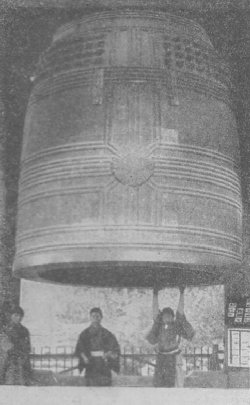|
Learned men estimate that there are at least 1,000 forms of religious worship practiced in the world to-day. These may be classed under four great heads, viz.: the Pagan, the Mohamedan, the Jewish and the Christian. Of these, the chief Pagan religions now existing are: Fetichism, Brahmanism and Buddhism, Confucianism, Taoism and the primitive religion of the North American Indians. The number of followers of Christianity is estimated at 506,000,000, with 800,000,000 followers of the other creeds. Thus it is that Christianity claims nearly two-thirds as many as the other sects combined. CURIOSITIES OF THE BIBLE The Bible bears no date. It comprises 66 documents, or books, and is supposed to have been written by 40 men. The Book of Isaiah has 66 chapters. There are 54 miracles recorded in the Old Testament, and 51 in the New Testament. The shortest verse in the Bible is John xi: 35, "Jesus Wept." In point of words, but not of letters, another verse is equally short, viz. : Thessalonians, v: 16, "Rejoice Evermore." The longest verse is the ninth verse of the eighth chapter of Esther. Esther is the only book in which the Deity is not mentioned. The Bible contains 3,566,480 letters, 773,746 words, 31,173 verses, and 1,189 chapters. The word, "Lord," occurs 1,855 times, and the word, "and," 46,277 times. The word, "Reverend," occurs but once, and then in the ninth verse of the 111th Psalm. The middle verse in the Scriptures is the eighth verse of the 118th Psalm. The 21st verse of the seventh chapter of Ezra contains all the letters of the alphabet., with the exception of the letter "J." In the Bible, are no words or names with more than six syllables. THE WORLD'S NEWSPAPERS In 1775, there were only 27 newspapers published in the United States. Now there are 18,657 in America; 7,000 in Germany; 9,000 in Great Britain; 4,300 in France; 1,976 in Japan; 1,500 in Italy, and the remainder are distributed throughout Australia, Spain, Switzerland, Holland, Belgium, Asia and Canada, the total number in the world being 51,234. The oldest newspaper in the United States, called the "Pennsylvania Gazette," is published at Philadelphia, and was established by Samuel Kreimer, in 1728. LARGEST BELL IN THE WORLD
Popocatepetl (smoking mountain), 35 miles southwest of Pueblo, Mexico, is the tallest volcano in the world. It is 17,748 feet above the sea level, and has a crater three miles in circumference, and 1,000 feet deep. The new opera house in Paris, France, is the largest in the world. It covers nearly three acres of ground; its cubic dimensions are 4,287,000 feet, and it cost about $100,000,000. The Mammoth Cave, in Edmondson county, Kentucky is the largest cavern in the world. The cave consists of a succession of irregular chambers, several of which are large, situated on different levels. Some of these are traversed by navigable branches of the subterranean Echo river. Blind fish are found in these waters. GROWTH OF THE GREAT POWERS The comparative numerical strength of the principal nations of the world has undergone many revisions during the last 103 years. In 1800, the great powers were thus grouped: Russia, 38,140,000 population; France, 27,720,000; Germany, 22,330,000; Austria, 21,230,000; the United Kingdom, 15,570,000; Italy, 13,380,000; Spain, 10,440,000; the United States, 5,310,000. In the year 1902, we had the following figures: Russia, 130,896,628; the United States, 79,725,456; Germany, 53,000,000; Austria-Hungary, 42,600,906; the United Kingdom, 49,559,954; France, 38,517,975; Italy, 31,000,000; Spain, 18,250,000. Of this population, the English-speaking races in Great Britain and Ireland, together with the English-speaking colonies, and the United States, number 133,109,543, as against Russia's 130,896,628. LOCOMOTIVE WORKS, LOCOMOTIVES AND CARS There are 28 locomotive works in the United States, and they represent a capital of $40,813,793. The value of their products for 1902 was $36,107,145, to produce which involved an outlay of $11,745,524, for wages; $1,243,350, for miscellaneous expenses; and $21,175,420, for materials used. At the 28 establishments 2,962 locomotives of all classes were built, aggregating a value of $28,345,256, compared with 2,409 locomotives, valued at $19,752,465, built in 19 establishments in 1890. In addition to these, 272 locomotives were constructed at 26 railroad shops, which were valued at $3,276,393. During the last ten years there has been a considerable increase in the cost of locomotives built. In 1890 an average locomotive cost $8,199; in 1902 the average price was $9,956. The increased price in construction is due to increased size and the materials used. In construction, Pennsylvania was first, with a record of 49.3 per cent of the whole, with New York state a close second, and New Jersey, third. The number of locomotives in the United States in 1902 was 39,584; the total car equipment, 1,550,833; and the total number of railroad employes, 1,071,169. The United States had at the same period, 195,571 miles of main track; 12,845 miles of second track; 1,154 miles of third track; 876 miles of fourth track; and 54,920 miles of yard track and sidings,—a total of 265,366 miles of single track. TOLD IN FIGURES |
